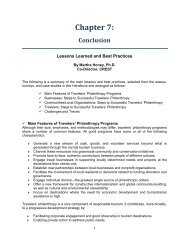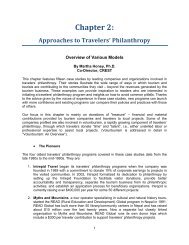Travelers' Philanthropy Handbook - Center for Responsible Travel
Travelers' Philanthropy Handbook - Center for Responsible Travel
Travelers' Philanthropy Handbook - Center for Responsible Travel
Create successful ePaper yourself
Turn your PDF publications into a flip-book with our unique Google optimized e-Paper software.
tax deductibility or other financial incentives in your appeal. Yes, you need to make sure yourcustomers know whether their contributions will be tax deductible ─ and <strong>for</strong> some, deductibilitywill be a consideration ─ but tax deductibility is rarely a primary motivating factor. Your appealmust focus on the benefits to the place (including not only the natural environment, but the wellbeingof people, protection of local cultural integrity, etc.). These are the factors that are almostcertainly behind the traveler’s motivation to contribute, as the results of Lindblad’s philanthropycampaign in Galapagos demonstrate (Table 4).In the year prior to introducing its more targeted communication campaign, Lindblad offeredguests both a tax deduction and the promise of a $250 voucher <strong>for</strong> use on any future trip withLindblad Expeditions in exchange <strong>for</strong> a contribution of at least that amount. As the table shows,although both incentives (the tax deduction and the voucher) were in place prior to rolling outthe new philanthropy campaign, guests’ contributions increased sharply the following year whenthe targeted messages were woven into Lindblad’s interpretive program. These results illustratethat a certain background percentage of guests would donate even without the targetedapproach, but a very significant increase (more than 270%) ensued when messages appealedmore directly to the philanthropic side of guests.These results should not be taken to mean that offering incentives such as tax deductions andvouchers is unimportant. Obviously, they have a role in travelers’ decisions about whether tocontribute. What the results show is that such external factors are not likely to be major decisiondrivers in and of themselves. In other words, fewer donations result if travelers receive offersthat emphasize only the financial benefits they will receive by making a contribution. Theresults in Galapagos illustrate the strong impact that appealing to guests’ philanthropicside can have on their propensity to give.Table 4. Comparison of Galapagos Conservation Fund donations be<strong>for</strong>e and after thephilanthropy communication campaign.*ChronologyTax DeductionOffered?$250 VoucherOffered?Year prior to introducingthe targeted philanthropycampaign (1997)Year the targetedphilanthropy campaignwas introduced (1998)*Note: Data <strong>for</strong> both years are from the same 80-passenger ship (Polaris). Do offer travelers incentives <strong>for</strong> contributing.147Amount ofContributionsReceivedYes Yes USD $1,800 per tripYes Yes USD $6,700 per tripReturning to the Galapagos example, Lindblad Expeditions has noticed that the most commondonation received since instituting the voucher system is either exactly $250 or a multiplethereof. This suggests that the effect of the voucher has been to establish a psychologicalanchor <strong>for</strong> the size of contributions, even though offering the vouchers hasn’t appearedto influence greatly the number of guests that contribute. Further, Lindblad says that only29% of the vouchers have been redeemed since the program started in 1997.So while non-philanthropic appeals might not themselves motivate a lot of travelers to makegifts, they can certainly fill another role. And it is probably safe to assume that <strong>for</strong> some















